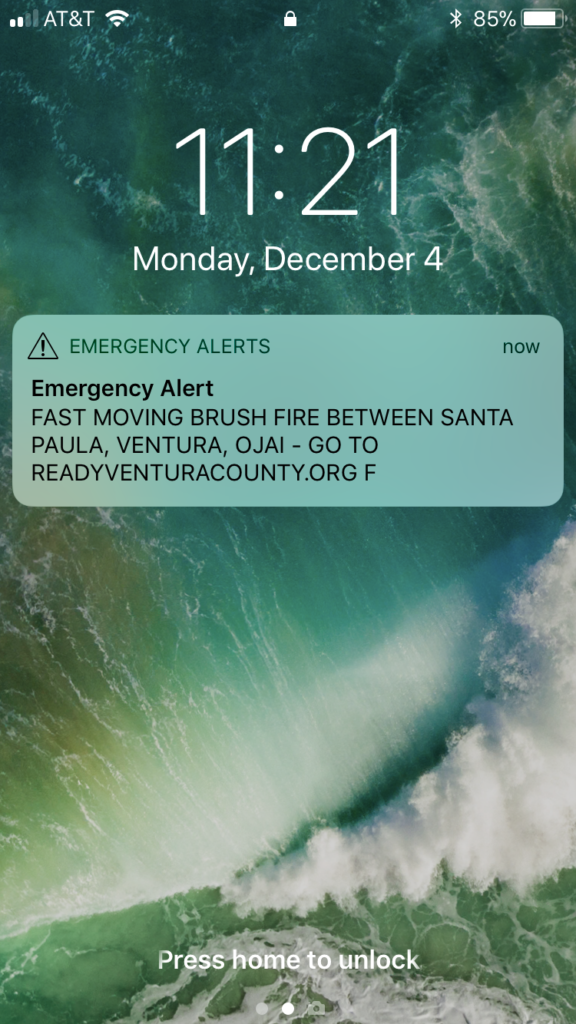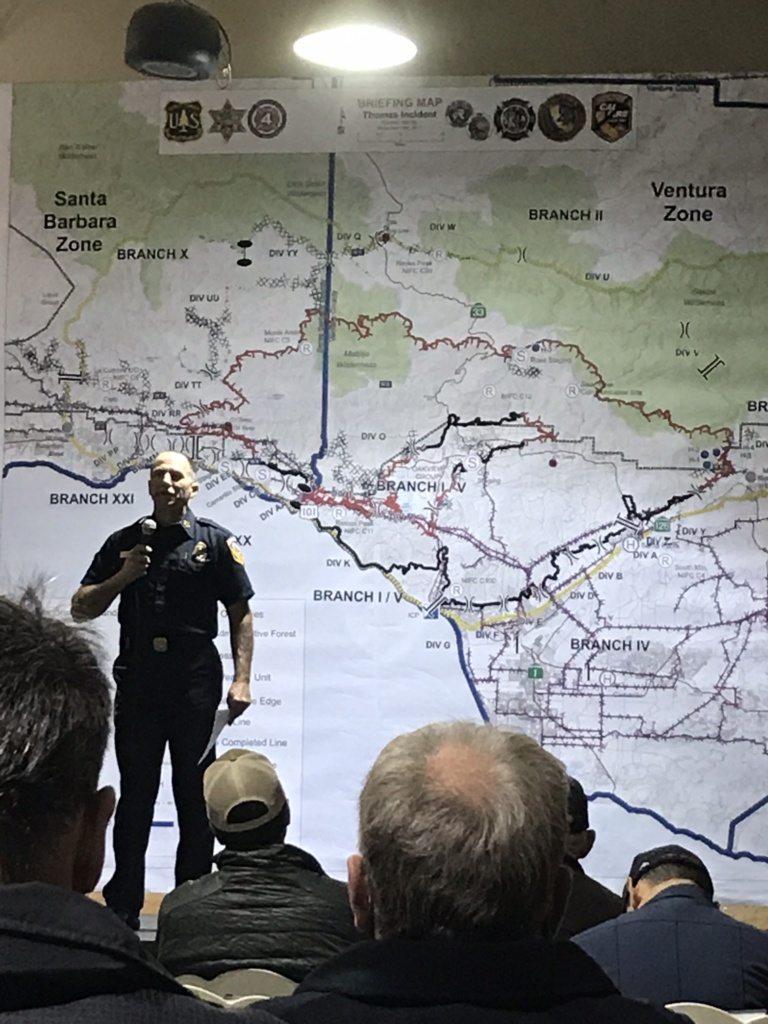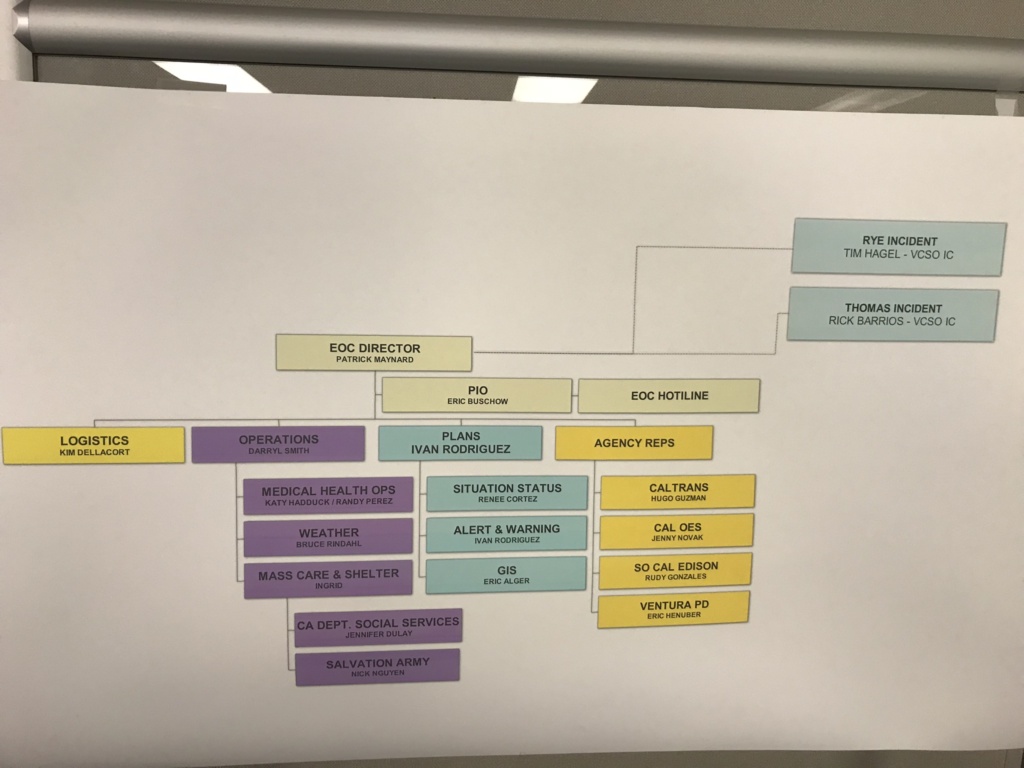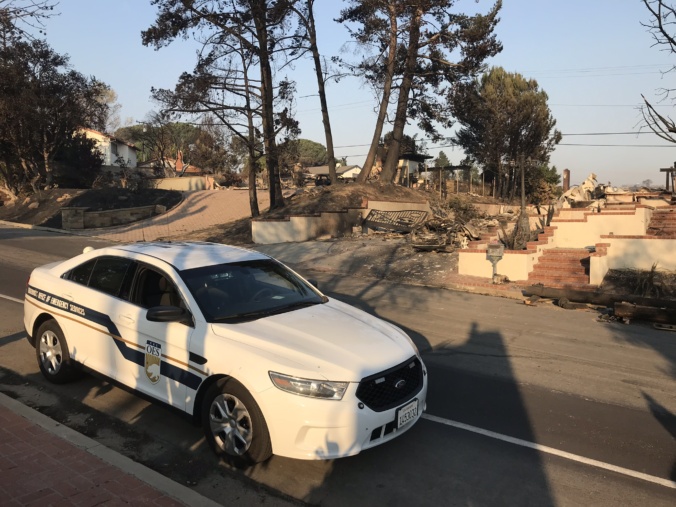Today marks two years since I made my first middle of the night drive 90 miles up the 101 freeway to respond to disaster in Ventura County. The Thomas Fire ignited near Santa Paula December 4, 2017 and within hours had forced evacuations 15 miles to the west in the City of Ventura. It would grow to become the largest wildfire in California history at that time. In 2018 I had the pleasure of presenting Ventura County OES with a California Emergency Services Association Exceptional Service Award for emergency management best practices in response to the Thomas Fire. There were so many lessons learned and so many emotional moments during the response that I can’t even begin to capture them all in one article.
The most critical function that was coordinated out of the Ventura EOC was the crafting and dissemination of emergency evacuation messages. This was the action that undoubtedly saved lives during the fast moving fire that started at night and threw people off guard when they realized ‘that brush fire in Santa Paula’ was lapping at backyards in Ventura. So today I am focusing just on the stellar emergency notification process that Ventura County OES honed during the fire. I’ll break down their EOC structure and processes into several parts so you can see how the system functioned.

Methods of Notification
In addition to traditional door to door notices by officers, news media partnerships and social media, the Ventura EOC primarily handled two methods: an opt-in system called ‘VC Alert’ that was coordinated through EverBridge software and the Wireless Emergency Alert through FEMA’s Integrated Public Alert & Warning System (aka the technology that gives us Amber Alerts). The EOC heavily used VC Alert with detailed information about who was being evacuated, since this information could be shared with very targeted geographic areas and everyone receiving it had already indicated their interest by signing up for the system. They could also receive notifications through email, voice call and text message. This method is great but since it relies on sign ups, they knew that it only reached a small fraction of the county’s population. On that fateful night, the Ventura EOC Director made the decision to ‘push the big red button’ and utilize WEA for their first time ever when they realized how dire the situation was and needed to get the word out far and wide as quickly as possible. The WEA alerted everyone with a cell phone in that part of the county about the fast moving fire and directed them to seek emergency information on the VC Emergency website. The number of characters that can be included in a WEA is limited so they had to be very concise and could not share evacuation area specifics.

Alert & Warning Coordinator
Both the WEA and VCAlert messages were crafted from an Alert and Warning position within the EOC’s Planning Section. This person was knowledgeable in EverBridge and IPAWS. it was definitely a highly skilled position that needed to be filled by highly trained VCOES staff. The position coordinated directly with an EOC liaison at the Incident Command Post in order to obtain the latest evacuation orders coming from Law and Fire. This position also provided the intel from the field to the Website Coordinators in the Situation Unit and to the Planning Section Coordinator and the EOC Director. He or she was always a very popular and busy person during the activation. If you wanted the latest and greatest information on what the fire was doing, you went to this person.

The EOC Liaison at the ICP
The EOC Liaison was physically stationed at the ICP although he/she was an actual Emergency Manager who was part of the VCOES team. I think this is a great practice because this person’s sole responsibility was to watch out for information about evacuations and immediately relay it to the EOC. When this responsibility is tacked onto the already full plate of fire and law personnel it may slip through the cracks. A physical presence is also important so that Incident Command will have that constant reminder of emergency management needs and resources that can be coordinated through the EOC. It is also great for building strong relationships with law and fire partners—standing side by side in the smoke together solidifies a bond that can never be replicated over the phone.
The Website Coordinator(s)
Within the situation unit, there was one person entirely dedicated to making sure that the VC Emergency website was kept up to date with all the current details of the incident. Most importantly this was evacuation information, but it grew to include information on shelters, school closures, air quality information, road closures, and more. It included a detailed, interactive map that was kept up to date with real time evacuation information through the assistance of a GIS specialist also working within the planning section. The website was such a critical mechanism for the public to maintain information about the response that it actually temporarily crashed due to high volume on the first night. It was certainly a lesson learned for future responses to ensure that your website can handle a sudden increase in traffic during an emergency situation. As the fire continued to burn and keep community members out of their homes for two weeks, the need for providing better real-time information in Spanish became apparent. They were originally using Google Translate to provide the information in Spanish, however the system was imperfect as ‘brushfire’ was translated into ‘hairbrush’ along with other unintentional translation mishaps. Ventura eventually expanded the team to add a bilingual website position that was responsible for keeping a Spanish version of the site up to date whenever the English version was updated.

The EOC Hotline
The Ventura EOC also housed a hotline call center with a minimum of 2 staff at all times to answer any inquiries from the public. The hotline number was shared far and wide on social and traditional media. The call volume would have put a burden on an emergency dispatch center and would have been overwhelming for a single public information position. Call center staff answered phones and mainly utilized the website to share information with the public about what was going on in the fire. Even though people could’ve just looked at the website on their own, many felt better about interacting with an actual human being. They were also able to request additional information or get messages into the EOC if needed. I believe this function is vital within or directly adjacent to an EOC and it is often overlooked with the assumption that dispatch will be able to handle it. Within the org chart, the call center fell under the Public Information function, and the Call Center Supervisor reported to the PIO for questions and connected the calls for media interviews to him.

The EOC Collateral Program
You might wonder how Ventura was able to staff all these positions using their emergency management team and the answer is that they didn’t. They created an optional program called the ‘EOC Collateral Program’ where staff from other county departments could volunteer to undergo training to augment EOC functions and earn overtime during emergency activations. This program is truly a best practice because everyone participating applied, interviewed, and underwent significant training. These staff viewed the experience as a privilege rather than as an unfortunate ‘other duty as assigned.’ The way this program was framed by OES as competitive and selective created a culture of people who actually wanted to help out in the EOC. People in this program staffed the website, situation status, call center, and logistics support functions.
Public Information Officer(s)
Both Fire and Law provided PIOs to the EOC. These PIOs were primarily responsible for giving media interviews, drafting press releases, and coordinating EOC visits for media or dignitaries. Social media for this response was handled by field personnel for fire and law. The EOC did not utilize its own Twitter Account for emergency notifications since they had not built up a following or trained on that method.

Saving Lives
Emergency notification is an extremely critical function that should be coordinated through the EOC rather than at the field level whenever possible. Ventura had learned from the mistakes of Sonoma County just two months earlier during the wine country fires of October 2017 when 44 lives were lost as the fire swept through neighborhoods in the middle of the night. Their decision not to use WEA limited the spread of life saving information, and I believe that Ventura’s decision to send its first WEA absolutely reduced the loss of life in the Thomas Fire. There is much that can be learned from the response and recovery from such a major disaster, but I believe these are the most salient emergency management lessons to be shared on this day of remembrance.

